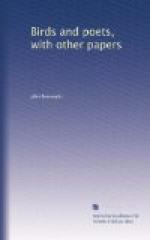In Solomon’s description of spring, the voice of the turtle is prominent, but our turtle, or mourning dove, though it arrives in April, can hardly be said to contribute noticeably to the open-air sounds. Its call is so vague, and soft, and mournful,—in fact, so remote and diffused,—that few persons ever hear it at all.
Such songsters as the cow blackbird are noticeable at this season, though they take a back seat a little later. It utters a peculiarly liquid April sound. Indeed, one would think its crop was full of water, its notes so bubble up and regurgitate, and are delivered with such an apparent stomachic contraction. This bird is the only feathered polygamist we have. The females are greatly in excess of the males, and the latter are usually attended by three or four of the former. As soon as the other birds begin to build, they are on the qui vive, prowling about like gypsies, not to steal the young of others, but to steal their eggs into other birds’ nests, and so shirk the labor and responsibility of hatching and rearing their own young. As these birds do not mate, and as therefore there can be little or no rivalry or competition between the males, one wonders—in view of Darwin’s teaching—why one sex should have brighter and richer plumage than the other, which is the fact. The males are easily distinguished from the dull and faded females by their deep glossy-black coats.
The April of English literature corresponds nearly to our May. In Great Britain, the swallow and the cuckoo usually arrive by the middle of April; with us, their appearance is a week or two later. Our April, at its best, is a bright, laughing face under a hood of snow, like the English March, but presenting sharper contrasts, a greater mixture of smiles and tears and icy looks than are known to our ancestral climate. Indeed, Winter sometimes retraces his steps in this month, and unburdens himself of the snows that the previous cold has kept back; but we are always sure of a number of radiant, equable days,—days that go before the bud, when the sun embraces the earth with fervor and determination. How his beams pour into the woods till the mould under the leaves is warm and emits an odor! The waters glint and sparkle, the birds gather in groups, and even those unused to singing find a voice. On the streets of the cities, what a flutter, what bright looks and gay colors! I recall one preeminent day of this kind last April. I made a note of it in my note-book. The earth seemed suddenly to emerge from a wilderness of clouds and chilliness into one of these blue sunlit spaces. How the voyagers rejoiced! Invalids came forth, old men sauntered down the street, stocks went up, and the political outlook brightened.
Such days bring out the last of the hibernating animals. The woodchuck unrolls and creeps out of his den to see if his clover has started yet. The torpidity leaves the snakes and the turtles, and they come forth and bask in the sun. There is nothing so small, nothing so great, that it does not respond to these celestial spring days, and give the pendulum of life a fresh start.




